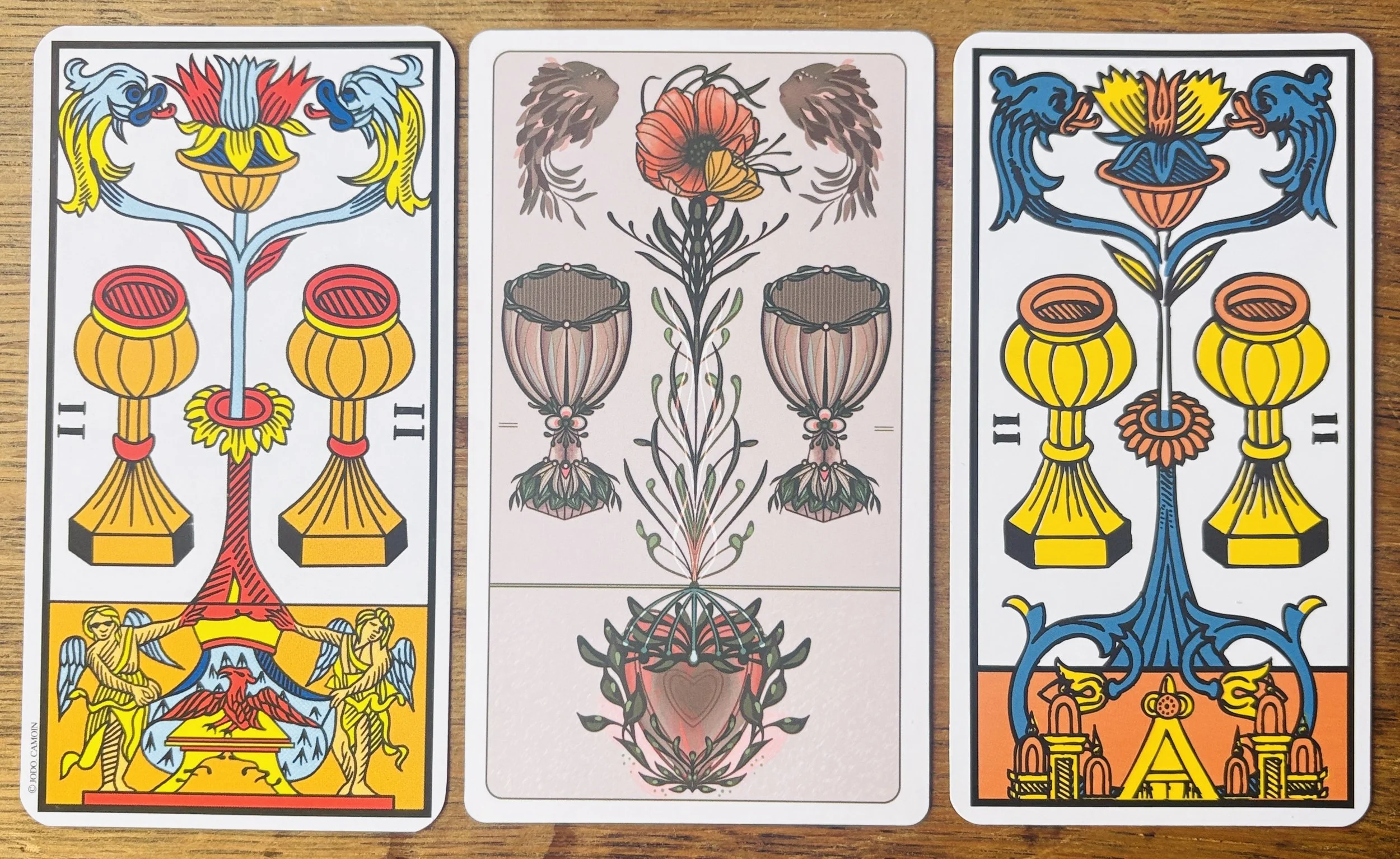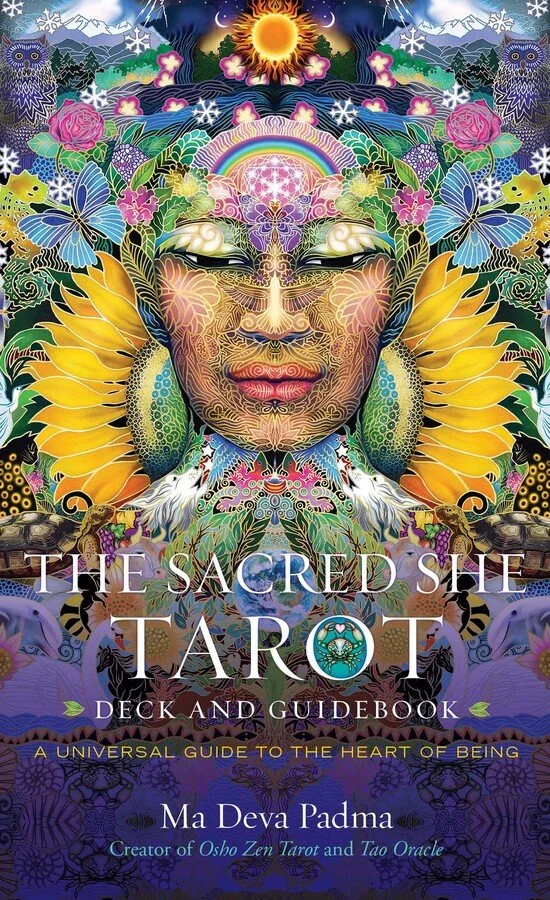My Favourite Decks for Therapeutic Tarot Sessions
Hello Tarot and Nature Lovers,
For a professional Tarot reader, I don’t actually have that many decks (about 20 … well, besides my teaching stock!), although I have purged around 30-40 decks over the years. I thought it would be enjoyable to do a different sort of post than usual, and to write about the decks that speak to me most, both personally, and also in my work as a Tarot Therapist.
My favourite three decks are in no particular order, and the caveat is that if I write a similar post in the future, it may well look very different. Everything in life changes, including one’s Tarot collection!
Tarot de Marseille
I was in two minds as to whether I should list this as one deck, as there are countless variations on the standard pattern. But to save this post from becoming a boring list of my favourite Marseille decks, I decided to put them all under one banner. The ancient Tarot de Marseille (printed via the woodblock technique from the 17th century onwards) pre-dates the more popular Rider-Waite-Smith deck/system by centuries, and the Minor Arcana ‘pip’ cards have a playing card feel on first look. But don’t be fooled by their simplicity. Simplicity is the Marseille’s major asset. The Major Arcana and Court cards feature quirky ‘mistakes’ (or are they?) that are often the most interesting things to read with. There are no set ‘meanings’ – you read what you see in the moment, sort of like the Rorschach ink-blot tests, only you enter a mysterious and colourful world instead of mini oil-spills. Say what you see in the moment! There’s your message. The Marseille’s secrets will never be revealed – no matter how much people try – and that is exactly why I love it so much. There’s nobody to tell you that you are wrong in what you see: and that is why it works so beautifully as a therapeutic tool: it reveals the unconscious mind of the individual, which is where the healing so often happens. There are so many variations on the deck, as well as two different ‘types’ of Marseille decks (which aren’t all that different from each other, really, and you need to be a geek like me to spot them), but my favourite versions are:
The Jodorowsky/Camoin version from the 1990s – a deck that pulls together symbols (or ‘mistakes’) from many ancient versions into one deck. It is gorgeously coloured and amazingly detailed.
The Metanoia Marseille from 2023 – a gentle deck made with digital art, staying true to the general Marseille pattern but adorned with gorgeous flowers (which often add extra meaning to the cards). It’s soothing and stunningly beautiful. My Tarot Therapy clients respond more warmly to the Metanoia Marseille than any other Marseille deck.
Paul Marteau’s version from 1930 – sometimes criticised by Marseille scholars for using the ‘wrong’ colour scheme (please), it is actually the deck’s deep soothing blues that make it so calming to work with.
Above: Two of Cups from three versions of the Marseille: Jodorowsky (left), Metanoia Marseille (centre) and Paul Marteau (right).
Osho Zen
Above: Ace of Rainbows (Pentacles/Coins) from the Osho Zen
I avoided the Osho Zen for years. I remember seeing it in a local charity shop years ago. I picked it up, looked at it, pulled a face and then put it down. I was put off by the keywords mostly, which to me felt limiting. (I feel differently about that now. Why do we accept ‘keywords’ and titles such as ‘The World’ in the Major Arcana, but not in the Minors? They can be useful, providing we don’t neglect the actual images in favour of them.)
Fast forward many years and I am a practising Zen Buddhist. A fellow Tarot Therapy counsellor recommends this deck to me, and sends me a free copy in the post, without me even asking for it. With my Zen Buddhist practice behind me, I see it with new eyes, and I’m using it with clients just a few days later. At times it is beautiful, at times brutal, at other times tongue-in-cheek: the Osho Zen is not a variation of the Waite-Smith Tarot (which so many thousands of decks are), but an entire Zen system of Tarot, a system as unique and important in its own right as the Marseille, Waite-Smith or Thoth (which are considered the three major traditions in Tarot). The Osho Zen system is designed to reveal our inner lives, not to focus on external events. One of the reasons that I avoided it more recently was because I assumed that the deck used the word ‘Zen’ in that new age, airy-fairy ‘Zen means relax’ sort of way, which is not what Zen practise is at all. But I was wrong to assume that. Osho’s teachings – which Ma Deva Padma’s card designs are based upon (and are shared in the excellent guide book that comes with the deck) – are as profound as any Zen master’s that I have ever come across. And what’s more, the deck is gorgeously colourful, imbued with Nature. It is direct and simple to use – yet its depths continue to reveal themselves. You’ll probably love it or hate it – and it’s clear how I feel! In some ways it couldn’t be more different to the Marseille, but that’s exactly why I love Tarot: it can go in so many fascinating directions.
Tarot of the Cat People
Above: Two of Cups from Tarot of the Cat People by Karen Kuykendall
This is the first deck that I ever owned. 20+ years ago, I was going through a bereavement and the Tarot called to me. I ended up in a glorious New Age/Pagan book shop in Manchester (where I lived at the time), where I chose this, my first ever deck, just from looking at the box through a glass counter. I bought a velvety tarot bag with a pentacle on it (I didn’t know what it meant) and I got my friend to buy it for me, because I’d heard that it was good luck to do it that way. I am so grateful that I chose Tarot of the Cat People, which was the only deck I used for my first decade with Tarot. The artwork takes you into another world, to another planet far away, a place that you can’t help but feel might actually exist out there. It features iconic symbolism – often revolving around cat body language – rather than esoteric symbolism; you can read with it without having to delve into the kind of symbols that lead you into other spiritual traditions such as Astrology or Kabbalah etc. (That’s just not for me, and I don’t regard them as intrinsic to Tarot.) I’m having a renaissance with this deck at the moment, remembering all of the reasons why I became so transfixed with Tarot to begin with, why it helped me through my grief – because I chose the right deck. Body language rules in this deck – that of the humans and the felines – making this beautifully relatable for most people, and there is a gentleness to the darker cards, too. When working with this deck, we leave this world of ours for a short time, and yet we are led to the centre of ourselves. The system is influenced by both the Marseille and Waite-Smith, but mostly it is its own beast altogether.
The above three Tarot decks work beautifully in Therapeutic Tarot sessions, because their symbolism is open to personal interpretation. None of these decks feature cryptic codes hinting at esoteric mysteries. I find that those sorts of decks can interrupt the flow of a therapeutic reading by hinting that some book somewhere will tell us what the symbol in front of me really means. I feel that what a symbol really means is to be deciphered in the moment, open to changing each time that you look at it. An angry-looking cat might mean one thing to me, a different thing to you … and that’s how it should be. Esoteric symbolism doesn’t tend to work like that. It’s magical if that’s your thing, but not so magical if it aint. (If you are interested in the use of ‘iconic’ symbolism in therapeutic Tarot sessions, you can take a peep at this slide that I use in Tarot Therapy training sessions.)
Other decks I adore but don’t work with as much (which may be good for Tarot Therapy or general inspiration…)
The Tarot de Marseille-Waite seamlessly blends the Major Arcana of the Marseille with the Minor Arcana of the Waite-Smith. Whilst I adore the Waite-Smith, some of the Major Arcana cards just don’t work for me (it’s those limiting esoteric symbols again). That said, the Minor Arcana in the Waite-Smith is a work of storytelling genius, and so it’s lovely to have this deck combining Marseille Majors with Waite-Smith minors!
Above: High Priestess from Ceccoli Tarot
Ceccoli Tarot was gifted to me by a friend about 10 years ago and I come back to it regularly. It is full of strange, girly, fairy-tale art. I would never have bought it for myself but, interestingly, it works powerfully for me, for reasons I can’t explain. Although I rarely use it for client work (some of the images are a little disturbing, which I like but appreciate that my clients might not), I find that it touches a deep place within me for personal readings and I sometimes use it in email readings. Like the Cat People, it feels like a world of its own, only this time it is a world of dreams, where deep meaning is to be found in the impossible.
Above: the gorgeous box from the Sacred She Tarot.
The Sacred She Tarot was designed by Ma Deva Padma, who designed the Osho Zen. It has the same simple but profound oracle-meets-Tarot feel, with touches of Buddhism that I really appreciate. It is colourful, lush and gentle, with vibrant Nature symbolism everywhere. Each card tells a divine story; it is a great deck for therapeutic client work as well. Sometimes, simply looking at the right Tarot card can be a form of therapy. This is most definitely the case with the Sacred She, whose heavenly colours and supportive figures (be they human, animal or plant) are medicine for the heart.
The 1980s Neuzeit (New Age) Tarot by Swiss prog rock musician Walter Wegmüller is a psychedelic dream! It feels like stepping into someone’s mushroom trip and floating up into rainbows. I don’t use it as much as the others, admiring it mostly as a work of art rather than a tool (I recognise that it’s an acquired taste!) – but a work of art it truly is. Oh, and you should also check out his Tarot album from the 1970s if experimental rock is your thing.
Above: The Hermit from Walter Wegmüller’s Neuzeit / New Age Tarot.
Finally, of course, the Waite-Smith Tarot (also known as Rider-Waite, Rider-Waite-Smith or RWS) is a work of genius, despite my few misgivings (I was being picky, forgive me). It changed the world of Tarot with its visually descriptive Minor Arcana cards and, although it’s not a go-to deck for me (although it has been in the past, and probably will be again in the future), it is understandable why it’s the go-to system for many. It is just so relatable, so readable.
Funnily enough, none of my favourite decks are explicitly Nature-themed, even though ecotherapy is such a big part of my work, including my work with Tarot. That’s probably another blog post altogether, but, for me, Nature is depicted and explored in the Tarot quite naturally already. (At least in the decks that I use.)
There you go, friends! So, what are your favourite decks? Do you like or dislike any of the decks I’ve listed? Why do you feel as you do? I honestly adore Tarot in all of its forms, and I hope that this comes across. I try not to be a Tarot snob (it can be tempting, but there’s enough of those already), and although I don’t ‘do’ esoteric decks, I can still understand their appeal. Tarot is a vast world, and it has room for its many interpretations. I could talk about Tarot decks all day and would truly love to hear about your favourites…. so please post in the comments if you are feeling in the mood :)
Smiles from Scotland,
Stephen
ps I’ve also just revealed a second post for the week – an exploration of the Judgement card from a Nature perspective.







